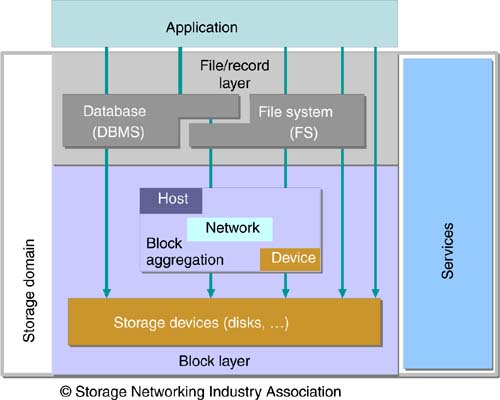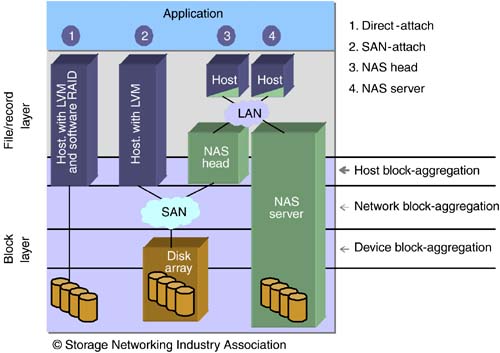2.1 Storage Building Blocks
| The basic elements of a computing storage system haven't changed in the last 30 or so years . The equipment and areas that control the primary interaction may have moved around, but at the end of the day, an operating system still initiates a request to a file system, which in turns talks to a volume management layer, and ultimately the storage devices themselves , as shown in Figure 2-1. Figure 2-1. Basic storage building blocks. The earliest server implementations of this architecture took place internal to the system but have since expanded outside the box into specialized equipment and software platforms. Intelligent disk arrays, switching infrastructure, and network transports have shattered the traditional blueprint for storage designs. This newfound geographic freedom for a wide variety of storage functions presents IT professionals with previously unavailable architectural options. In today's global computing environments, these options help save time and money. The SNIA shared storage model serves as an excellent reference for outlining storage architectures. Specifically, the model provides a navigable map for the variety of functions that make up a complete storage system. 2.1.1 STORAGE GUIDANCE: File Systems, Volumes, and BlocksThe model in Figure 2-2 provides an abstraction of how applications address storage, allowing IT administrators to effectively plan complete architectures. It carries the simplified model in Figure 2-1 further by calling out specific mechanisms that file systems and volume management use to access storage devices. In the case of the SNIA model, one can roughly equate volume management with block aggregation. Figure 2-2. The SNIA shared storage model. Applications are the common starting point for the model. From there, all other mechanisms fall into the storage domain ”database management systems (DBMS), file systems (FS), and all of the ways to connect to disks. The connection to the physical disk drive may be direct from the server or host, through a storage network, or through a device such as a NAS head or NAS server. Each of these areas ”host, network, and device ”may perform the block aggregation functions required to deliver blocks to the upper-layer file or record layer. One benefit of the SNIA shared storage model is the ability to map a variety of storage architectures onto a single framework. In the case of large corporations with storage deployments spanning direct-attached storage (DAS), NAS, and SAN-attached storage, viewing these seemingly separate hardware infrastructure across common dimensions can help rationalize purchases and resources across the storage organization. Further, this optimized view helps IT managers plan and architect corporatewide solutions serving multiple departments, enabling greater efficiency. Figure 2-3 highlights the versatility of the model in depicting multiple architectures within one framework. Item one, DAS, connects directly from a host, or server, with its own logical volume management (LVM) to a set of disks. In this case, the host provides software redundant array of independent disks (RAID) functionality to the unintelligent disks, often referred to as just a bunch of disks (JBOD). File system and volume management functions reside on the host. Note that the host box covers the entire space of the file/record layer, and covers host block aggregation in the block layer of the diagram. Item two is similar, but now the host connects to a disk array across a SAN. It still has some host block aggregation (i.e., volume management), but now some of the aggregation, such as the RAID functions, are shared by the device, which overlaps with device block aggregation in the block layer of the diagram. Figure 2-3. The SNIA shared storage model depicting direct-attached, SAN-attached, and network-attached storage. Items three and four change the storage access mechanisms to file-based, as opposed to block-based . Note that a local area network (LAN) resides between the host and the NAS head and NAS server, and that each NAS unit overlaps into the file/record layer. The communication requests from the hosts to the NAS units are file-based , used for corporate file sharing, for example, compared to block-based hosts (items one and two), which use a SCSI-based access mechanism (SCSI, Fibre Channel, iSCSI) to communicate with the disks. |
EAN: 2147483647
Pages: 108


